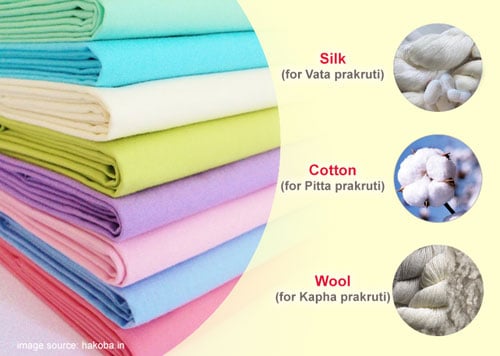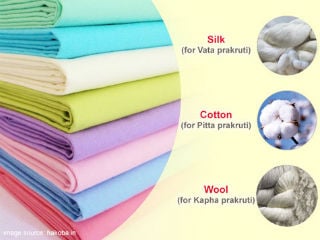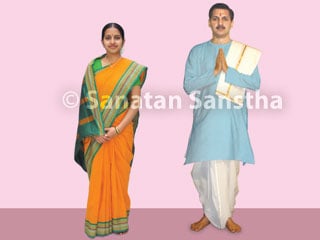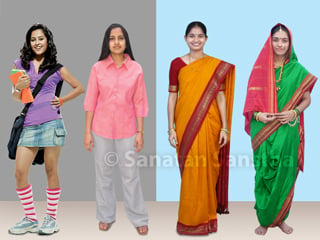An average individual should wear sattvik clothes so that he can imbibe Chaitanya (Divine consciousness) from them. This article explains type of cloths and the advantages of clothes made from natural fibers over those made from artificial fibers.

1. Clothes made from natural fibers
A. Valkal
Clothes made from the bark of a tree are called valkal. The Ramayan mentions that Shriram, His wife Janaki and brother Lakshman discarded royal clothes and wore valkal when they set out to dwell in the forest.
B. Importance of clothes made from natural fibers
-
Cotton and silk being natural fibers, their contact is conducive to the good health of the skin.
-
Since cotton and silk are natural fibers, clothes made from them have greater ability to attract the Divine Principle. Hence, an individual who wears such clothes gets greater benefit of the Divine Principle.
-
When compared with clothes made from artificial fibers, clothes made from natural fibers have greater ability to imbibe and retain sattvik vibrations. Hence, they are less susceptible to the attacks of negative energies. That is why; natural clothes remain pure and holy for a longer period.
C. Cotton clothes
-
Cotton clothes immediately absorb sweat from the skin, thus preventing it from becoming sticky; also, the skin remains healthy and lustrous.
-
The nirgun (Non-materialised) Divine waves are imbibed in the cotton on the plant. Hence, wearing cotton clothes gives a comfortable feeling and increases the sattvikta (Purity) of the wearer.
D. Silk clothes
-
Silk clothes are soft in feel. The friction between the silk clothes and the unwanted hair on the body causes the hair to fall off. The touch of the silk clothes helps in keeping the skin soft.
-
Silk fibers attract the subtle-most waves of Deities. Hence, the individual wearing silk clothes can imbibe these Divine waves.
-
A silkworm sucks the essence from the tree and creates silk fiber using its saliva. This fiber has luster and softness. Silk fibers attract the Principles of Deities from Heaven.
-
A silk garment is the most sattvik among all clothes. It is only because of the sattvikta in silk clothes that they are worn during ritualistic worship of a Deity, during auspicious occasions and as sovale.
2. Type of Clothes made from artificial fibers (nylon, terylene, rayon and polyester)
A. Chemical constituents of the artificial fabric reduce the benefit of the Divine Principle
Fabrics such as nylon, terylene, rayon and polyester contain chemicals and hence the extent to which the Divine Principle is imbibed by them is restricted. Therefore, the benefit rendered by the Divine Principle is reduced.
B. Since clothes made from artificial fibers attract Raja-Tama
components, the intensity of attacks of negative energies on them is maximum
Since the energy of attraction of the gross (energy that attracts Raja-Tama components) is the influencing factor in artificial fibers, do not use clothes made from artificial fibers such as polyester, nylon, rayon etc. The intensity of attacks of negative energies on clothes made by using these fibers is very high. Therefore, such clothes are considered to be prohibited during ritualistic worship.
3. Nylon, rayon, wool, cotton and silk cloth
| Nylon | Rayon | Wool | Cotton | Silk | |
|---|---|---|---|---|---|
| Principle | Inferior sagun (Materialised) | Medium sagun | Sagun | Sagun-nirgun | Nirgun-sagun |
| Gun (Component) | Tama-Raja | Raja-Tama | Raja | Sattva-Raja | Sattva |
| The Absolute Principle underlying the task | Pruthvi (Absolute Earth Principle) | Pruthvi-Apa (Absolute Water Principle) | Pruthvi-Apa | Minimally Pruthvi-Apa | Tej (Absolute Fire Principle) –Apa |
| The level at which they are imbibed and/or emitted | Attract the Tama component | The momentum of emission of the Tama component is high | Imbibing and emission of Raja component | Accumulation of Sattva component | Accumulation and emission of Sattva component |
| The effect on the individual | Getting irritated | Body becoming Heavy | Faster completion of the task | Completion of the task with virtuous thoughts | Awakening of bhav (Spiritual emotion) while performing the task makes the karma an akarma |
| Purity / Impurity | Body and the surrounding area becoming impure | Mainly body becoming impure | Purification of the gross body | Purification of the gross body and the mental body | Purification of the gross body and the subtle-body |
4. Comparison of different type of cloths –
washed and unwashed, new and used clothes
Effects of wearing unwashed (dirty) and dhutavastra (Washed clothes)
Dirty clothes have a lot of Raja-Tama-predominant waves accumulated in a gross state. When such dirty clothes are worn, there is every likelihood of the gross as well as the mental body becoming impure because of the contact with the Raja-Tama-predominant waves. This increases the possibility of developing serious physical disorders and the mind getting engrossed in non-sattvik thoughts. Therefore, avoid wearing dirty clothes. The touch of a dhutavastra helps accumulate Sattva component in the body; an individual begins to lead a value-based life and begins to march towards the spiritual goal. Therefore, one should always wear dhutavastra.
Subtle effect of unwashed and washed clothes :
-
Since washed clothes are not charged with the individual’s vibrations and dirt, their ability to attract Sattva component is high. Hence, the proportion of creation of black covering on washed new silk clothes is lesser than that on unwashed new silk clothes.
-
Even though the clothes are sattvik, since they are not washed Raja-Tama accumulates over them; this reduces their ability to imbibe sattvik waves. Hence, the proportion of negative energy attacks on such clothes is higher when compared with new silk clothes.
-
The proportion of sattvik waves attracted towards silk clothes is higher; hence, the proportion of negative energy attacks on them is lesser than on cotton clothes.
-
A higher proportion of dirt in unwashed clothes causes greater hindrance to the flow of sattvik waves that are attracted towards it and as a result, the extent of black covering on it is higher.
Reference : Sanatan Sanstha’s Holy text ‘How should the clothes be from a spiritual perspective ?’


 Sewing Clothes and Effect of Stitching
Sewing Clothes and Effect of Stitching Practical suggestions on Wearing Clothes
Practical suggestions on Wearing Clothes Why do we wear clothes ? and Importance of wearing Sattvik Clothes
Why do we wear clothes ? and Importance of wearing Sattvik Clothes Significance of taking saree pallu (free end of the saree) over head
Significance of taking saree pallu (free end of the saree) over head Subtle effect and Importance of dress worn by a woman
Subtle effect and Importance of dress worn by a woman Subtle effects of different neckline patterns of a garment worn by women
Subtle effects of different neckline patterns of a garment worn by women